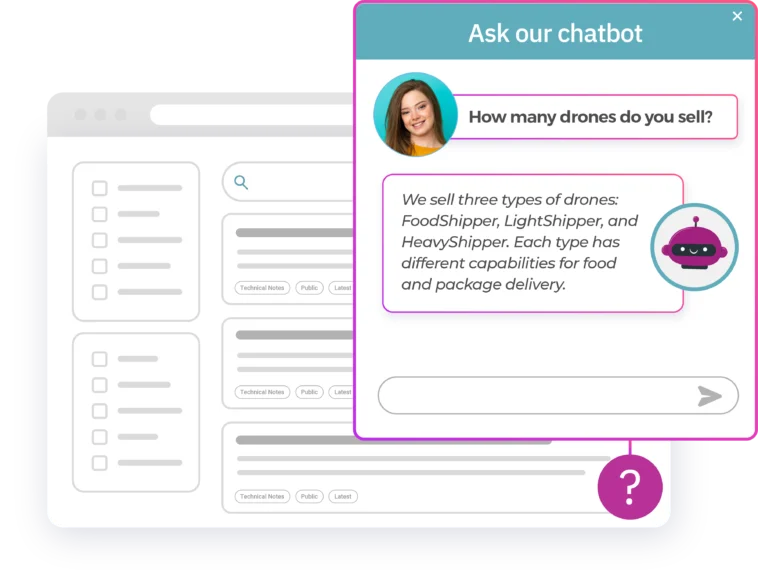Customer support teams are overwhelmed with support requests. They’re always looking for ways to streamline the user ticketing process to decrease the number of help desk tickets coming their way. With 57% of customer experience leaders predicting support calls to increase in volume by 20% over the next few years, it’s time for businesses to rethink how they help their customers.
As a result, companies are exploring self-service opportunities to bolster their support efforts. Forward thinking companies are even investigating AI-powered self-service options to cut the number of support tickets. However, one of the most effective strategies to solve this key customer support challenge is ticket deflection.
To get you started, we’ve outlined the benefits of ticket deflection, how AI innovations can enhance your results, our top tips to maximize your strategy’s impact, and how to measure this key metric.
What is Ticket Deflection?
Ticket deflection, or case deflection, refers to the customer support strategy of reducing the number of support requests by helping customers find answers on their own through self-service channels. The goal is to ensure users get access to relevant content to solve their issues and avoid having to reach out to a company’s support team.
The average case deflection rate in the technology industry is 23%, meaning that 23% of customers are finding what they need through self-service rather than contacting support.
To increase this average and optimize how customers find the information they need, we first need to break down what ticket deflection looks like.
How Does Ticket Deflection Work?
Ticket deflection works by leveraging self-service options such as customer portals, knowledge bases, FAQ pages, community forums, AI chatbots, and more. By centralizing information and resources for troubleshooting, answering questions, and learning about a product, you can eliminate frustration and reduce the need for costly live support.
Once your information is centralized, another great opportunity is to use this available content for help desk ticket deflection through proactive content recommendations. When users begin to fill out a support ticket, the system can suggest content that may help address their issue. Obviously, the recommendations must be relevant to solving the issue in the ticket. Users can review these resources and attempt to resolve their issue on their own. If the provided content effectively helps them solve the problem, they can avoid submitting the support ticket altogether.
For ticket deflection to be effective, two key elements must be implemented: a customer portal and advanced AI capabilities.
Use a Customer Portal
One of the essential parts of successful self-service, and by extension ticket deflection, is customer portals. These secure digital centers are where customers can access all relevant company content from a single source.
Customer portals allow users to take control of how they engage with a company and its content: search for needed documentation, follow the latest product updates, interact with knowledge content, submit support requests, and even contribute to community forum posts.
Implementing a portal serves as the front-line defense against unnecessary support tickets by providing valuable self-service opportunities and easy access to content.
Bring AI into your Self-Service Tools
Take your customer self-service portal to the next level by supercharging it with the latest AI functionalities. Generative AI (GenAI) helps automate responses to user questions, and when done right, leads to more satisfied customers. What are some AI use cases that improve ticket deflection?
- GenAI Applications: AI is more than a buzzword, it’s a tool that creates real differentiation in the solutions of companies who know how to use it. There are several applications of this technology that deepen how users interact and engage with product content. The most advanced self-service solutions must take advantage of GenAI’s natural language abilities to stay ahead of the competition.
- Personalized Recommendations: Implementing personalized content suggestions for each user is essential. Machine Learning algorithms should be used to analyze user behavior and search patterns and therefore facilitate the recommendation of customized search results.
- Identifying Content Gaps: Track dedicated content metrics that highlight common search terms that yield no search results. Then, let your content writers use GenAI tools to construct the first version of the missing content. It can then be edited by technical writers and quickly published. As a result, users can find the information that was previously missing, so they no longer need to open a support ticket.
- Integrate Chatbots and Conversational AI: Taking your AI applications one step further, integrate a conversational question-and-answer layer over the application to make it more interactive for users. AI-enabled chatbots understand user queries and provide clear and concise responses in just seconds. They communicate in language that feels so natural, customers will think they’re speaking to a human support agent! However, to ensure your chatbot’s answers are relevant, you also need Retrieval Augmented Generation, or RAG. RAG enhances the chatbot’s outputs by connecting to a reliable source of information, like your company’s knowledge base. As a result, you’ll provide a chatbot that offers accurate and product-specific answers to user questions. This improves case deflection by helping customers quickly find precise solutions without agent intervention.
Benefits of Ticket Deflection
There are many benefits to deflecting customer support tickets with self-service — let’s look at some of the top ones.
Cost Reduction for Support Teams
As more cases are deflected, users create less support tickets. Support agents can focus on more challenging level 2 and 3 help desk tickets. Operational costs are further reduced since self-service options are available to help users at any time of day without needing to pay extra to keep more agents on call after hours.
Improved Customer Experience and Satisfaction
Ticket deflection enhances the customer experience by providing quick solutions to user issues. Customers want to solve issues on their own but don’t always know where to look for information. Case deflection tools like chatbots and recommendation systems provide the answers and content that users need, taking the guess work out of self-service.
Increased Scalability of Support Services
Self-service tools can provide 24/7 support in any language to customers around the world. Users get the help they need when they need it without putting the burden of round-the-clock service on support teams. As a result, more customers are satisfied without heavily increasing support resources.
Common Challenges in Ticket Deflection
There are several pain points that teams face when implementing new strategies for ticket deflection. Here are four challenges that you may encounter.
- Lack of Specialized Expertise: Certain products have complex mechanisms that require extensive subject-matter expertise to resolve different issues. If the person attempting to resolve the issue doesn’t have the base level know-how or access to certain tools, they may still require more specialized one-on-one assistance.
- Efficacy of Self-Service Tools: For case deflection to be successful, you need to offer easy-to-use self-service tools to your users. The quality of these tools is impacted by several elements including the quality of the search engine, information accuracy, and integration of the tools into all customer touchpoints. Inconsistent or low-quality self-service will negatively impact your case deflection rates.
- Quality of the Knowledge Base Content: Products continuously evolve and so does your documentation. Ensure users have access to any new or updated information within self-service tools or else they won’t find what they are looking for. If your content is out of date or unavailable, your customer self-service efforts will not succeed in deflecting support cases.
- Access to Customer Feedback: Combat ineffective content by providing opportunities for customer feedback (e.g. which documentation is the most or least useful, content with different terminology, missing content, etc.) and content ratings (e.g. giving one to five stars or sending a thumbs up or down). Without direct feedback and dedicated content analytics it is difficult to improve ticket deflection rates over time.
1. Centralize All Your Knowledge
Consolidate your knowledge into a centralized knowledge hub so it is easily accessible to be delivered to different AI tools and endpoints like user portals, help centers, and in-product help.
How Fluid Topics Does It: Fluid Topics is an AI-powered Content Delivery Platform (CDP) that ingests and unifies product information – from manuals to API documents to support articles – into a single source of truth no matter the initial source and format. Our solution delivers the most relevant and personalized content to any digital channel, device, and application, in context with the user’s needs and environment. As a result, customers easily find answers to their questions without searching through multiple sources.
2. Implement a Strong Search Engine
To optimize your customer experience for ticket deflection, consolidate your company data into a single, centralized search index. That way, customer searches will analyze the same database and deliver consistent results regardless of the entry point.
How Fluid Topics Does It: The Fluid Topics Content Delivery Platform seamlessly connects to all your content sources and unifies your knowledge in a single search index. Your teams can benefit from RAG and semantic search to ensure your applications (i.e. chatbots) deliver the most relevant, accurate, and trustworthy information across all use cases.
3. User Profile Management
Profile management plays a crucial role in ticket deflection by personalizing and streamlining the support experience for users. You don’t want to overload users with irrelevant content in their self-service search results.
How Fluid Topics Does It: Fluid Topics checks user management profiles to provide specific responses to user questions based on their role and content access level. By combining user roles management and keyword and semantic searches users receive more relevant answers.
4. Ensure Multilingual Support
Multilingual support helps in deflecting tickets by allowing customers to find answers in their preferred language through self-service options like FAQs, knowledge bases, or chatbots. Providing support in the customer’s language can also significantly improve their overall experience, making them feel valued and understood.
How Fluid Topics Does It: Fluid Topics combines LLMs and machine translation to provide on-the-fly translation. This allows users to accurately translate any content when they need, in the language they need with a simple click. From user search queries to search results pages and displayed content, every element undergoes real-time translation.
5. Integrate AI Capabilities
There are several GenAI applications that are well suited to improve the user troubleshooting experience. Implementing AI tools is a must to offer a competitive ticket deflection experience.
How Fluid Topics Does It: Our out-of-the-box GenAI assistants allow users to generate content summaries, explain code snippets, outline step-by-step instructions, or even extract a list of tools needed for a technical procedure. With these functionalities, users interact more thoroughly with your content and resolve their issues faster.
6. Develop a User-Friendly Design
Behind a strong ticket deflection strategy is an intuitive user experience and user interface. Different documentation portal and knowledge base solutions offer varying levels of autonomy and branding.
How Fluid Topics Does It: Our page designer offers companies the option to build their own documentation portal with a variety of “drag and drop” components to customize the look and layout of their knowledge base. Businesses have full control without needing any special technical intervention.

7. Use Customer Feedback
To optimize your ticket deflection rate, you need to monitor the efficacy of your content and take steps to update documents that don’t provide the necessary level of support.
How Fluid Topics Does It: Our CDP allows users to provide feedback or ratings for your content. Alongside direct feedback, track which documents and search terms are the most and least popular. Similarly look at which search queries yield no results. This information will help prioritize your content updates. This provides technical writers with a direct line of communication on how to produce content that optimizes the troubleshooting experience.
Measuring the Success of Ticket Deflection
As with all new strategies, it’s important to measure results. Depending on your methods and the tools you use to boost case deflection, there are several ways to track your performance.
How to Measure Ticket Deflection
To calculate the ticket deflection rate, first take the number of self-service interactions. This includes all self-service actions across your knowledge base, community forums, customer portal, and more. Then, divide this number of self-service interactions by the total number of help desk tickets that users submitted to your support team.
You can further analyze how specific self-service tools are contributing to case deflection. For example, to measure the ticket deflection rate of a chatbot, you first need to determine how many users interacted with the chatbot over a specific period. Then, divide that number by the number of users that still created help desk tickets over the same period.
In parallel, you may wish to measure the support costs saved thanks to your deflected tickets. One way to calculate this is to take the number of times users clicked to start a support ticket and subtract the number of submitted support tickets. Then, you multiply the resulting number of deflected tickets by the average cost of a support ticket to calculate your savings.
How you measure ticket deflection depends on how and where you use it as well as the specific measurement you want, so adjust your calculations accordingly.
Conclusion
Ticket deflection and self-service are crucial to enhancing your customer support. 65% of support teams report decreased call volumes since investing in self-service support options.
Moreover, the latest advancements in Generative AI offer beneficial applications. GenAI makes the content reading and chatbot experiences more accurate, personalized, and contextualized — three things that help users get the answers they need. Finally, if you’re not sure where to start, let us help you.
Fluid Topics’ case deflection feature seamlessly integrates into your user platforms and has a proven track record of helping our clients reduce their support ticket volume.
Latest post













